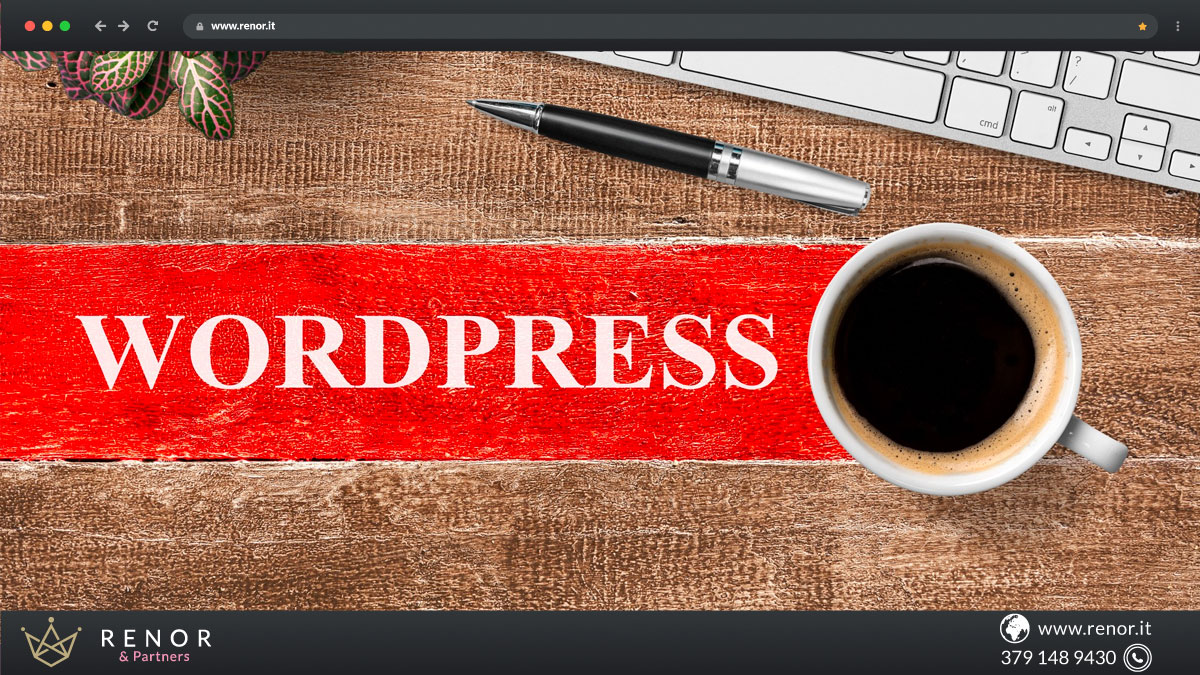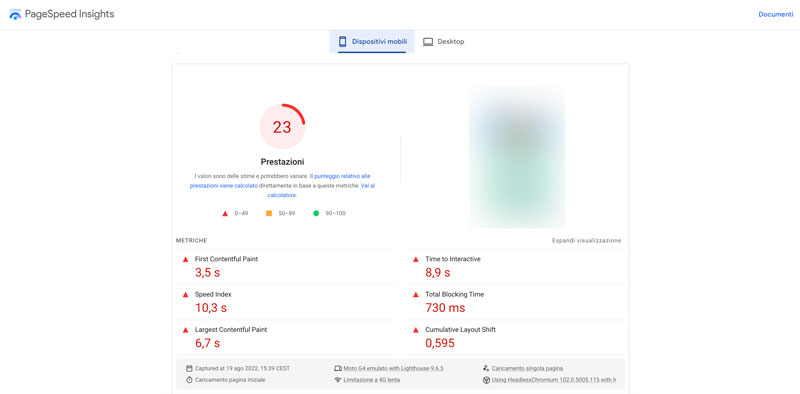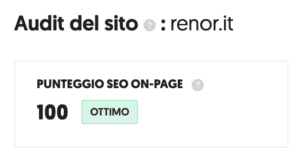
RENOR & Partners è una società di consulenza d'impresa con alti standard qualitativi e con i prezzi più bassi del mercato.
RENOR & Partners S.r.l.
Via Cicerone, 15 - Ariccia (RM)
info@renor.it
WordPress or custom solution?
WordPress or custom solution?

This post is also available in:
Italiano (Italian)
There is no doubt that WordPress is the most widely used CMS in the world, the community has more than 55000 plugins, it is easy to install, there are plugins to customize themes without the need to write a line of code, it integrates a blog on which it is easy to write articles, it has plugins for SEO curation, and you name it. If everything is so great why are there still custom sites that do not take advantage of plugins?
Some motivations
Although the strengths of this CMS are clear, there are many things that the average user may not know about not being an insider.
There is a way and a way to develop websites
How many of you have fallen to the temptation of getting a site developed for 300 euros all inclusive? Well, here’s some news for you… You have thrown your money away!
Developing a site just to say, “Hey man! I made the site,” is perfectly useless. Since time immemorial, when you decide to buy a product you do it because it has to be useful for something. A site developed with 300 euros is a useless site. There is little to go around. With 300€ it is impossible to put in place all those virtuous development practices necessary to make the site pleasing to search engines.
The speed of loading
Sites pulled up at a cost of 300€ are sure to integrate a WYSIWYG (What You See Is What You Get) plugin. These plugins are notoriously heavy, using lots of JavaScript and a myriad of CSS that is mostly not even used. Let’s face it: they are mainly used by those who don’t know how to develop and want to make their own “unpretentious little site” or by those who, aware of the SEO implications, don’t give a damn just to deliver a job sooner and make cash.
Banco alle ciance! Numbers in hand. In either case, the result will be this:

Such a site will be lucky to appear on the 100th page of the search engine, unless you have done painstaking work on SEO by studying content for compound keywords that are more likely to rank, or have a number of articles and content that integrates all human knowledge, then yes, you can turn a blind eye to the loading speed, but if you have made such compromises let alone focus all this attention on SEO and content!
Therefore: unnecessary expense!
Image optimization
A well-done site has had behind it the work of a webmaster who has spent a great deal of time optimizing images for the Web.
Today there are formats designed to aid site loading speed, formats that offer a small size while maintaining decent image quality.
In addition, images should be resized for their intended use. If I need to fill a small area of 300 x 200 pixels with an image, it is bad-practice to upload a 2400 x 1600 pixel image.
At 300€ per site this care cannot exist because it is time-consuming, so one prefers to take and upload the image as is and resize it via CSS by adding a couple of attributes to the tag (much faster operation):
<img src="./images/img01.jpg" width="300px" height="200px" alt="" title="" longdesc="" />
Too bad the image weighs 4 megabytes! Basically just loading this image, from mobile would take 4 to 5 seconds with 4G coverage, compared to the 20 Kb of the same optimized image, which would load in about 30 milliseconds.
Also prominent in the above line of code are three attributes that are useful for SEO and intentionally left unfilled: each image should have an alternate text, a title, and a long description. The search engine pays attention to these details because they are useful for the blind to interpret the content of the image. Therefore, in addition to representing additional words to be categorized for SEO purposes, engines tend to reward those who also think of the less fortunate. Of course, filling out these fields also takes time, and I doubt that $300 sites have done prior research on keywords they can rank with and have gone out of their way to provide descriptions of all the images they include.
Just to give you an idea of the time frame, an article comes out on this blog every day…. The motivation is not due to a lack of desire to write or a lack of imagination: we have hundreds of article titles to write in our editorial plan, the problem is that between SEO analysis and drafting, an article takes half a day to write… And do we still want to waste time talking about a €300 site?
Postpone CSS and JS blocking the display
The browser when it receives the requested site data processes CSS and JavaScript in the order they are written and blocks the display of the page until those files have been fully loaded. This further lengthens the time it takes to interact with the site. Some of these files may not be needed immediately and can be delayed. In essence, one must simply tell the browser that those files can be loaded after the page content has loaded. This practice gives the user who is opening the site a way to view it and be able to interact with it much sooner. This practice lowers what search engines call the bounce rate. Basically if a site takes 20 seconds to load at 6 seconds 80% of visitors have already left.
Delete unused CSS and JavaScript fragments
Definitely difficult operation to perform on projects using CSS-JS frameworks! The developer would have to access the framework’s CSS and JS files looking for all those classes (for CSS) and functions (for JavaScript) that are not called within the site pages and delete them. Under normal conditions this would not be the end of the world, but it is not easy to find what you need inside a file where the most user friendly name for naming a variable is “var k.”
The practice of replacing user-friendly variable names with short variables is put in place by the framework developers to reduce the size of the file that the browser will have to load, but it makes the JavaScript code written within it virtually unreadable. In essence, it is an unworkable practice.
One operation that can certainly be done involves minification of all CSS and JS. The entire file is written in a single line by eliminating the “carriage return” information and spaces within it. This saves an amount of space that can average 20 to 40 percent of the original weight. All this results in a shorter loading time at the same download speed.
Web sites visually all the same
When using these shortcuts you immediately notice a similarity between all sites. Want it or not, the CSS classes always are! As much as you can then customize there always remains a very similar visual impression between sites that were developed using WYSIWYG Plugins or Frameworks.
Are we therefore saying that WordPress is a CMS to be avoided?
Absolutely not. WordPress is a great CMS for creating websites with blogs and eCommerce, as long as you develop themes to the rule of art, without using these kinds of shortcuts that make the investment made to have a website online absolutely useless.
This site was also developed with WordPress, but not in half a day…. In a couple of months. It possesses a style that will be impossible to find on Sites developed with the shortcuts we have talked about, it has optimized images, optimized SEO, Sitemap updated in real time and definitely the cost of development was not 300€ unless you find a developer to work for you at 150€ a month!
For that matter, the Audit speaks for itself….

As you may have guessed, it’s not a matter of choosing WordPress yes or WordPress no; it’s. as always, a matter of evaluating how you work on WordPress and making all the appropriate assessments if you don’t want to throw money away.
Alas, most online sites are precisely developed by “phantom web agencies” in precisely this way, trying to go on the speed of development and the number of clients trapped in the net like fish caught in the sea, foisting on them low-paying websites, developed just to get the client to see the site online and which turn out, however, to be completely useless for the purposes for which a website is supposed to be built: attracting new clients.
In Italy for some years now there has been an air of “excessive facilitation.”. It is thought that everyone can do everything with little effort. I am sorry, but that is not the case! It is only fair that someone sooner or later will take the responsibility to say that if you are a Cook you will be great at your job but you cannot develop websites.
The cons of WordPress
As the most popular CMS in the world, it is also the one most stormed by the Hacker community. More than 16 million online sites have been developed using WordPress, the step is short: I find a flaw in WordPress and I can extend it to 16 million sites.
The WordPress community is always working to improve the core of the CMS, so much so that updates to the Core are released from time to time, but beware, there are also Plugins that are often developed by third-party agencies, and they may have closed their doors, so they will no longer release updates and someone will sooner or later find a flaw.
In fact, most attacks on WordPress come precisely from flaws in plugins and themes (which are no exception). Developing your own theme from scratch allows you to limit attacks on the theme front precisely because of the fact that if the theme is yours it will be unique and there is no Hacker in the world willing to find systemic flaws on a theme used by a single site, unless your name is INPS or Internal Revenue Service.
Basically, you should preferably go for plugins that have millions of installations and ensure that the Software House that developed them stays alive to ensure updates to their plugin over time.
WordPress to be safe needs to be updated continuously, as soon as an update is available.
From the latest versions it is also possible to set automatic updates, both for the WordPress core and plugins.
When it is not advisable to use WordPress
There is no rule, you just use common sense…. Personally, I would not use WordPress for purposes for which it was not designed. Remember that WordPress started as a CMS for Blog integration, for any other project I would think about it before using WordPress.
I would not use WordPress in case the key word of the work to be done was: performance. Not because WordPress itself is slow but because, I remind you, in order to run it makes calls that for some projects might be totally unnecessary.
Structuring a Custom project implies that you write only and exclusively the code that serves the purposes for which the site or web application was designed. Similarly, I would use Custom solutions to avoid worrying about having to update themes and plugins, especially when some plugins have not yet been updated to work properly on a new WordPress core. This could generate problems with site usage.
Basically when the budget allows, I am always for implementing custom solutions: more reliable, better performing, safer… Of course, as long as you don’t pay 300€ for them.

